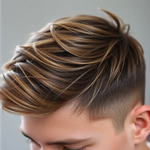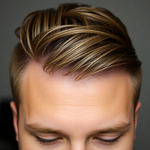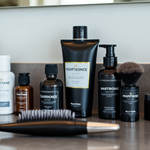
Color Tuning: Use Semi-Permanent Hair Color to Harmonize a Minimal Men's Capsule Wardrobe
05 October 2025
Share
Color Tuning: Use Semi-Permanent Hair Color to Harmonize a Minimal Men's Capsule Wardrobe
Introduction
Color Tuning: Use Semi-Permanent Hair Color to Harmonize a Minimal Men's Capsule Wardrobe — sounds technical, but it’s a simple trick that yields big style returns. If you want outfits that read intentional without buying a dozen new pieces, a small tweak to your hair tone can make neutrals look sharper and skin tones glow. Read on for a full playbook: from shade selection to maintenance, plus real-life examples and product notes.
Why Color Tuning Works for a Minimal Men's Capsule Wardrobe
Capsule wardrobes thrive on cohesion. When most pieces are neutral, small contrasts matter. Your hair frames your face and is one of the first things people notice; it can pull an outfit together or throw it off. Color tuning — adjusting hair undertone with semi-permanent color — harmonizes that frame with your clothes so each outfit looks intentional rather than incidental.
The smart-ROI of subtle hair changes
- High style impact with low cost and risk.
- Semi-permanent color fades gradually, so you can test looks without long-term commitment.
- Works with small wardrobes: fewer pieces, clearer visual language. Hair becomes another tool for color consistency.
Color Tuning: Use Semi-Permanent Hair Color to Harmonize a Minimal Men's Capsule Wardrobe
That phrase is your strategy: tune hair tone to match the dominant palette of your capsule. Say you live in navy, white, and charcoal — aim for cool ash tones. Live in camel, olive, and cream? Add warm honey-gloss to your hair. The framing effect makes clothes feel curated.
Understand Undertones, Contrast, and Your Face
Before you pick a product, understand three basics:
- Undertone: Skin and hair have cool (blue/ash) or warm (gold/amber) undertones. Matching or purposefully contrasting undertones changes how your complexion reads.
- Contrast level: High contrast (dark hair, light skin) vs low contrast (similar hair/skin tones). Adjusting hair tone shifts perceived contrast — useful if you want to soften or sharpen your look.
- Overtone: The visible tint — a gloss or slight bronze. Semi-permanent products usually deposit overtone without lifting natural color aggressively.
Quick rule of thumb
- If your wardrobe is mostly cool colors, introduce cool/ash hair tones to avoid clashing.
- If your wardrobe is warm, add warmth in hair to make camel and olive pop.
- If you wear mostly black and gray, a subtle blue-black or glossy neutral adds depth so outfits don’t look flat.
How to Choose the Right Semi-Permanent Shade
Choosing a shade is about undertone first, level second. You want harmony, not a drastic makeover. Consider these steps:
- Audit your capsule: Count dominant colors and list top five pieces you wear most.
- Identify the tone cluster: cool, warm, or neutral.
- Pick a product that deposits tone (glosses, color-depositing conditioners, or semi-permanent dyes labeled for subtle shifts).
- Aim for 1–2 tone shifts. If your hair is dark brown, don’t try for light brown with a semi-permanent product — instead choose a warm chestnut gloss or a cool ash gloss.
Examples
- Cool capsule (navy, charcoal, white): Ash-gray gloss or cool brown deposit to neutralize brassiness.
- Warm capsule (camel, olive, cream): Honey-chestnut or golden brown deposit to add warmth.
- Black-heavy capsule: Blue-black or cool gloss to create richness and dimension.
Step-by-Step Application Guide
Do it right and you’ll get natural-looking results that last weeks. Here’s a simple routine for at-home application, plus notes on when to see a pro.
- Prepare: Buy a semi-permanent product with clear instructions. Pick sulfate-free shampoo/conditioner for later.
- Patch and strand test: Do a skin patch and a small strand test 48 hours before full application to check for reactions and expected tone.
- Clean start: Apply on clean, towel-dried hair for even uptake.
- Application technique:
- For overall tone: Apply from root to tip following package timing (10–30 minutes usually).
- For depth without obvious roots: Apply mostly mid-lengths and ends, or thin the product at the roots.
- Rinse cool: Use cool water to seal cuticle and extend color life.
- Post-care: Use color-preserving products and avoid daily hot showers.
- Maintenance: Repeat every 4–8 weeks depending on fade and product type. Use color-depositing shampoos weekly to refresh tone.
When to see a pro
- If you’re correcting brassiness or gray coverage beyond a subtle shift.
- If you want dimensional color or blending with highlights.
- If you’re unsure of shade selection—many barbers now offer men’s color services.
Keeping Color in Sync with Seasonal Wardrobes
Your capsule likely shifts by season — lighter layers in summer, heavier textures in winter. Use color tuning to match seasons:
- Spring/Summer: Add warmth or brightness (soft honey gloss) to complement lighter fabrics and sun exposure.
- Fall/Winter: Deepen tone slightly (chestnut or cool brown) to match heavier textures and richer palettes.
Skin Tone, Age, and Gray Hair: Specific Strategies
Not all hair and skin situations are the same. Here’s how to tailor tuning:
- Fair skin: Avoid heavy warm overtones that can read orange. Subtle ash or neutral gloss keeps a clean look.
- Medium/tan skin: Warm tints (golden or chestnut) look healthy and natural.
- Darker skin: Blue-black or cool neutral gloss deepens tone without looking flat.
- Grey or salt-and-pepper: Use a blue-based gloss sparingly to clean up yellowing and enhance a crisp, modern gray.
Products and Sustainability
Look for semi-permanent formulas that emphasize gentle ingredients and low environmental impact if that aligns with your values. Menll.com’s Essentials collection focuses on durability and sustainable materials — ideal for a capsule wardrobe that lasts. For color products, prioritize ammonia-free, low-odor formulas and brands with transparent ingredient lists.
Internal resources: Explore Menll.com's essentials collection for capsule-ready pieces: menll.com/collections/essentials. For grooming and maintenance tips, see our guide on basics: menll.com/blog/grooming-basics.
Health and Safety
Always prioritize safety when using hair color. WebMD has a straightforward overview on hair-dye safety that’s worth reading before your first application: webmd.com/hair-dye. Key points:
- Do an allergy patch test 48 hours prior.
- Follow timing instructions precisely to avoid irritation.
- Protect your scalp and eyes — rinse immediately on contact.
Cost, Time, and Practical Considerations
Budget and time are major factors for men managing a capsule wardrobe. Here’s what to expect:
- At-home semi-permanent kits: $10–$30. Quick application: 20–45 minutes including prep and rinse.
- Salon services for tone-only gloss: $30–$80. Professional blending and advice included.
- Maintenance time: 10–30 minutes every 4–8 weeks for touch-ups, or 5–10 minutes weekly for color-depositing shampoos.
Real-Life Scenarios and Anecdotes
Picture this: You’ve got a capsule of navy tees, dark denim, and a camel coat. Your face looks a bit washed-out next to those cool navy pieces. A single session with a cool ash gloss neutralizes warm brass in your hair and suddenly your face reads cleaner; the navy tees stop making you look tired. That’s Color Tuning in action — small change, big confidence boost.
Style Pairings: What Hair Tone Pairs with These Staples?
- White tee + denim jacket: Neutral gloss keeps the look crisp.
- Camel coat + dark jeans: Warm honey tones in hair create harmony and richness.
- Navy blazer + charcoal trousers: Cool ash or neutral brown enhances professional polish.
- All-black outfits: Blue-black or neutral sheen prevents flatness and adds dimension.
FAQ
Will semi-permanent color damage my hair?
Generally, semi-permanent formulas deposit color without lifting the natural pigment, so damage is minimal. Choose conditioning formulas and avoid overlapping repeated color sessions too close together.
How long will the effect last?
Expect 4–8 weeks depending on product, washing frequency, and water temperature. Color-depositing shampoos extend the life between applications.
Can I switch tones often?
Yes. Semi-permanent makes seasonal or monthly shifts easy. Just avoid contradicting undertones in short succession; give your hair a couple of washes between very different tones.
Checklist Before You Start
- Audit your capsule wardrobe tones
- Decide on subtle undertone change (cool vs warm)
- Buy a semi-permanent product and color-safe care items
- Do patch and strand tests
- Plan initial application and maintenance schedule
Final Notes and One Honest Tip
Color Tuning: Use Semi-Permanent Hair Color to Harmonize a Minimal Men's Capsule Wardrobe is less about changing who you are and more about refining how you present yourself. Start subtle. Let your hair softly echo your wardrobe, and you’ll notice that outfits that once felt plain now read cohesive and intentional.
Engage
Which tone are you leaning toward — cool ash or warm chestnut? Drop your pick in the comments and tag a mate who’d benefit from a small style upgrade. Want curated capsule pieces that pair well with tuned hair? Browse Menll.com’s Essentials collection to get started: menll.com/collections/essentials.
Vorheriger Beitrag

Semi-Permanent Hair Color Micro-Routines: 3 Low-Waste Shade Swaps to Unlock More Looks from a Compact Men's Capsule Wardrobe
Aktualisiert am 06 October 2025
Nächster Beitrag

Semi‑Permanent Hair Color: A Shade‑First Travel System to Pack a Compact, Sustainable Men's Capsule Wardrobe
Aktualisiert am 30 September 2025





